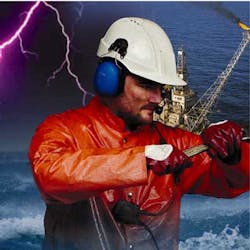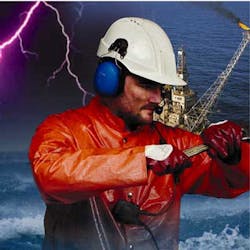Protective headsets counter low frequency noise
In the working areas of offshore facilities low frequency noise is a fact of life. Thrumming engines, hammering compressors, mud pumps, and other equipment provide a constant drone that can both injury delicate human ear structures and interfere with essential communication between workers. This is especially true on the drill floor and in the engine rooms of offshore vessels, whether a mobile drilling rig, operating platform, or service vessel.
To combat these problems, Peltor has developed a series of protective headsets with built-in communications. These headsets are designed for use in high-volume noise environments that effectively control low frequency noise.
For extremely noisy environments like rig floors, the H10 headset uses a mechanical dual-shell design to minimize resonance in the system and provide smooth attenuation over the whole frequency range. The two cups have different resonance and are separated by a layer of special compressed foam, which dampens energy like a shock absorber. The ring connector between the cups and the ear cushion is a new design which minimizes sound transmission.
Multistage damping
The headset system thus provides multistage damping of high amplitude sound to protect the ear. By creating a quieter local environment around the ear, hard-wire communication is easier. The integrated microphone mitigates outside noise with multiple holes in the rear of the microphone.
By allowing air pressure to affect both sides of the microphone membrane, the background signal is canceled. In effect, the microphone measures sound from both sides of the microphone, but then transmits only the voice signal. Communication between workers is improved two ways: first, by creating a quieter environment for the ear, and second, by creating a clearer microphone signal from others in the work group.
The headphone system is explosion safety approved. A semi-conductive plastic exterior removes any static build-up. The secret is metal dust imbedded in the outer shell that spreads and removes any static charge.
Completing the system is a sealed switch/talk button that is approved to IP-65 standard. The printed circuit board is sealed within the plastic cover to protect the switch from humidity and other fluids. Among its other features are:
- Positive click and sound
- Rotatable/removable spring clip
- Urethane connector cable (guaranteed to 200,000 flexes)
- Simple to use with gloves.
Further developments
Worksite communication headsets are generally used with hard-wire connections. This limits motion and can be awkward in certain situations. To address this problem Peltor is perfecting a new wireless headset using Bluetooth technology. Bluetooth is a radio communication method developed by Ericsson for short distance data communication involving a special radio link.
The system works in full Duplex over the 2.4 GHz operating frequency, a worldwide standard, and up to seven Bluetooth units can be linked at a time. Two alkaline batteries power the individual headset communication system up to 15 hours of talk time.
The headset permits wireless connection with cellphones at a range of about 10 meters and the phone does not need to be within sight. There will be solutions in the future for other radio devices as these arrive on the market. Wireless communication has obvious benefits for workers. They will be able to communicate hands-free and unrestrained by either communication wires or high noise environments. This will increase worker efficiency and improve the safety of operations.
For more information, contact Ulrik Svensson, Peltor. Tel: +46 (0)370 69 42 00, fax: +46 (0)370 69 42 80, e-mail: [email protected].

